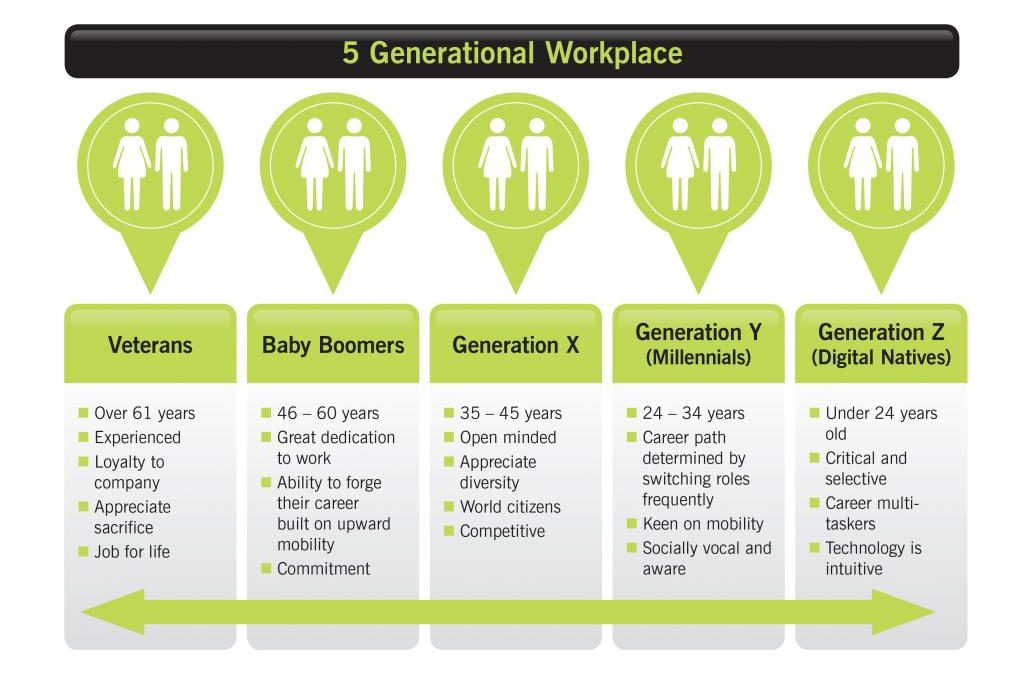In recent years we’ve witnessed the emergence of four (and soon five) generations in the workforce. Differences and diversity can help build a highly productive environment, but the management of these differences is key to any workplace success.
While this new norm is definitely something to be celebrated, it comes with its own challenges, especially for managers. Generation X managers, for example, can find themselves caught between managing two generations older than them and two generations younger than them, a difficult feat that can’t be achieved with one overarching approach. To manage them well, it’s important to know each generation’s unique characteristics in the workplace.
Each generation has its attitudes, mindsets, preconceived notions and experience. While each one is increasingly unique, there is one characteristic that each of these five generations share – they are all participants in today’s workforce.
Longer lifespans, delayed retirement and an eagerness to begin working earlier are just few of the reasons we are seeing a greater span of generations working together than ever before.
While traditionalists are mostly leaning towards retirement and Generation Z is just beginning their first wave working, each generation is still prominent and unique in the average workplace.More needs to be done to make the most of what each generation has to contribute while responding to their expectations, needs, values, views and working styles.
As always, demographics are generalisations and stereotypes with the purpose to understand overall trends, not specific situations. Also, just because you may be born in an era, you may or may not exhibit the behaviours of the generation.
Whilst Traditionalists adhere to their moniker, in respecting traditional approaches to delivery of work and hierarchy, they are also wells of knowledge who have significant learning to pass on. For Baby Boomers, they created the title ‘workaholic’, being competitive and often associating work and status with self worth and position. They carry a strong work ethic and highly developed communication skills and make excellent role models for younger generations. Generation X though broke the norm – they were the first to challenge the assumption of loyalty to one company – for them, respect is earned and not expected. They tend to IT literate, informed and independent and often challenge the status quo. Millennials, have just recently overtaken Generation X as the largest generation in the workforce. Millennials tend to be most interested in self improvement and are determined to grow in their own fields – they are socially and IT confident and need constant communication from their peers and managers – energetic, optimistic and with strong social consciences, the impact of this group on the workforce is not to be underestimated. Finally Generation Z is just entering the workforce – growing up fed on digital and social media, they are experts in technology; they are open and sharing ( sometimes too much) and rely less on face to face interaction happy to replace that with virtual and remote communication.
The key is to be able to effectively address and take advantage of the differences in values and expectations of each generation. While it’s important to understand what drives each generation, it’s equally important to not dwell on differences. Here are a few tips to help a multi-generational workplace succeed
- Conduct regular engagement surveys to keep a pulse on needs
- Motivate with the right rewards – using survey feedback to understand what works best for different generations
- Build collaborative relationships. We understand and appreciate others more when we have the opportunity to get to know them. Creating opportunities for employees of different generations to interact
- Create opportunities for cross-generational mentoring. This can work both ways—don’t automatically assume that younger generations will be mentored by older generations. All age groups have opportunities to learn from each other.
- Consider life paths. Understand where your employees are at in their life paths in terms of responsibilities and interests they may have outside the workplace. But don’t make assumptions. It’s important to remember that employees, regardless of generation, share both commonalities and differences.
Ultimately, managing generational differences in the workplace is all about creating an environment where people understand and appreciate various points of view, even if they differ from how they saw things going.
By understanding the different mindsets and tendencies of different generations, you can make your efforts go further by creating a less fragmented workforce and making people of all ages build relationships with each other. Appeal to the right people in the right way and you will have a workforce that operates beyond mere policies and processes, and strives to put in that extra amount of effort.
To find out more contact Consulting Partner Donal Laverty.


